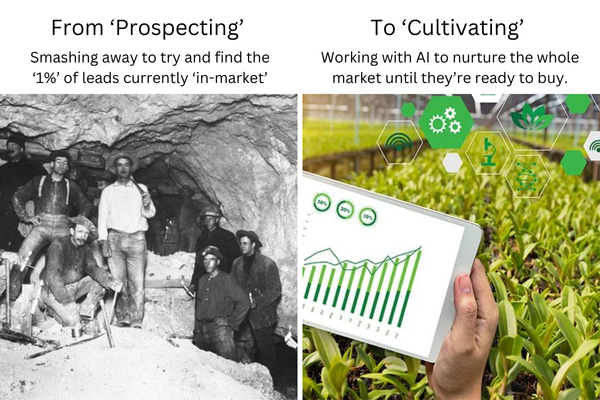From Prospecting to Cultivating

How to switch from a prospecting to cultivation mindset which benefits everyone to grow more sustainably.
It’s a well known saying that if you want to get rich in a gold rush, sell picks and shovels.
As it turns out, that marries up to the facts of who made the most money in great historical gold rushes, like the California Gold Rush of 1848-1855.
Merchants and the early minors were the ones who made their fortunes; the majority left as poor (or worse off) than before they arrived.
And so it is with today’s world of outbound prospecting.
Some businesses have gotten very rich (Outreach, Salesloft etc.) from selling infrastructure to businesses looking to make their fortune; as did some of the early SaaS adopters who cracked the ‘Predictable Revenue’ playbook in its early days…
But these days, there’s precious little gold left. And a whole lot more prospectors.
To try and find what little value there is left, new industrial sized tooling (think AI SDRs) is being sold to mine the tiny seams of active prospects remaining, damaging the environment further for everyone.
An inconvenient truth
Here’s why this ‘crank up the volume’ approach is fundamentally the wrong answer to the challenge of decreasing outbound conversion rates and shrinking pipeline.
There are no more buyers than there were 10 years ago. If anything there are less, with higher levels of budget scrutiny.
Sending 100x more emails and/or cold calls doesn’t create more demand, it saturates the existing market and forces them to tune out everything.
With just 1-3% of your total addressable market being open to a purchase decision at any given time, it's akin to using a wrecking ball to crack a nut.
There has to be a change in mindset.
We need to move from ‘prospecting’ like it's still a gold rush (a zero-sum game), to ‘cultivating’ like we’re farming the land to produce regular harvests.
This is a difficult mental framework to adopt, because traditionally the concept of ‘farmers’ is a negative one in new business, based on the idea they’re just passively taking orders and don’t have the grit or ambition to go out and compete for new business.
The opposite of a farmer was a ‘hunter’, someone who could go and take down their quarry with little more than a spear (and a well crafted sales pitch!)
10 years ago, perhaps this was a reasonable position to take.
But when all the game is gone, what are hunters going to hunt, particularly as their weapons have gone from spears to machine guns?
We need to reset our thinking and rebuild a relationship to market ecosystems that respects and works with our potential clients.
Even if they’re not ‘our’ clients yet, shouldn’t we be nurturing them? Helping them to grow?
Imagine if every vendor actually focussed on improving the health and wellbeing of the businesses in their market?
Providing them with answers to their questions; sharing best practices; offering insights, frameworks and benchmarks that improve how they manage and grow their business or execute their roles.
Sharing inspiration and fostering creativity.
Educating their future leaders.
Would the market expand?
Would those who offer the most value likely come out with the largest share of this expanded market?
Would trust and credibility increase?
Would folks be less likely to avoid conversations with vendors at all costs, increasing human connections again?
Would it be a more enjoyable and rewarding environment to work in?
We believe the answer is yes.
This is the essence behind taking a Value-Led Growth approach.
It’s switching from a broken ‘prospecting’ mindset to a ‘cultivation’ mindset that believes in abundance and long-term sustainable growth.
Sounds great, but I’ve got to hit quota this month!
We hear you, but consider this…
You also need to hit it next month, and next quarter, and next year.
The problem with chasing your tail for short-term outcomes, with short-term tactics is you’re forever in debt to the future.
You just have to borrow more and more, until eventually you can’t pay it down.
This is why so many sales teams have major peaks and troughs; they’re playing an unsustainable game.
It’s why just 25% of reps hit quota in H1 ‘24 (based on an analysis of over $54 billion in revenue from Ebsta).
Here’s the thing.
Consistently investing in doing the right things compounds over time.
The power of compounding is not to be underestimated.
As Warren Buffet famously said, “Compound interest is the eighth wonder of the world. He who understands it, earns it … he who doesn't … pays it.”
Most SaaS businesses are paying it right now, because they’re not taking the right approach.
Switching to Value-Led Growth means that rather than continuously borrowing and taking withdrawals out of your trust and credibility bank, cutting bad deals and exaggerating the truth just a little too much…you can reap the rewards of sharing value and they’ll actually increase as time goes on.
Unless you don’t plan on being in business (or in role) 6 months from now, we’d encourage you to rethink your time horizons in which you’re operating.
But how?
Set the right culture. Be deliberate about setting a culture that is buyer centric and focuses on a consistent approach to delivering value to everyone in your market.
Hire the right folks. Bring is sales and marketing team members who are curious, empathetic and believe in building long-term relationships. This doesn’t mean they won’t challenge prospects (far from it), but it does mean they’re doing it with the right intent (to help them achieve their goals and overcome their challenges).
Empower them with the right infrastructure. You’ll need to install the processes, systems and tooling that make it easier for your team to share value with prospects during every interaction. This means supporting their efficiency, without making them feel redundant in the whole process.
AI allows you to abstract away the mundane, boring and repetitive tasks they would have needed to go through, giving teams more time to collaborate between sales & marketing, commit to training and development, and focus on the more unique aspects of sales like building rapport on calls and problem solving.
Focus on the right metrics (and time horizons). Building a Value-Led Sales approach isn’t an overnight exercise. If you’re expecting to drive immediate results from the latest ‘best practice’ tactic or templates shared by LinkedIn gurus, it's not the right fit.
This is about committing to a way of compounding domain health, deliverability, open rates, CTRs, responses, conversations…and ultimately high quality pipeline that converts at a higher rate, because you’ve invested in the fundamentals of building trust and credibility.
Create and share resonant content. This is the nuts and bolts of a VLG approach, as it's how you help to share value with your audience across every interaction.
It doesn’t mean you have to be constantly publishing new original content, but you should be finding and sharing news stories, updates or other relevant insights from your industry, tailored to each prospect you want to engage with.
The key here is not to make them do the work, it's your role to synthesise the most relevant points, share why they’re useful and how they might be applied.
Doesn't that take a tonne of time and resources?
It doesn’t have to!
Leverage AI to help you understand more about your prospects, synthesise content, articulate relevance and augment your team's productivity.
Utilise 3rd party content where you can, so you don’t need to build a huge internal media machine.
Start small and build over time. Run a VLG motion in parallel to your existing outbound motion so you don’t have to be worried about ‘turning the taps off’ and only switch when the compounding nature of VLG starts to outstrip the performance of your existing campaigns.
How is this different to content/inbound marketing?
Whilst Value-Led Growth is very content-heavy, there are 3 major differences to the typical ‘content/inbound marketing’ playbook.
More direct (less reliant on paid promo or SEO). By leveraging emails and LinkedIn messaging, you don’t need to rely on the whims of LinkedIn or Google algorithms to promote your content. You can go directly to people’s inboxes.
And this also removes some of the need to just spend heavily on paid promotion across search and social.
Peer to Peer versus company to market. Most content is written by the company and addressed to the overall market (sometimes refined by ICP). This is fine, but has to be quite broad.
Value-Led Growth is executed more like peer to peer, with an individual rep sharing highly relevant content to one specific prospect, based on their own unique context and needs.
Focus is really on relevance than ownership. Content marketing is built on creating your own content. And whilst VLG benefits from leveraging your own content, it isn’t restricted to it.
Those taking a Value-Led Growth approach will happily utilise other content and resources out there, ultimately transforming them by synthesising the specific take-aways relevant to each prospect.
Cultivating success together!
If you’re keen to move away from the frenetic, near-sited world of prospecting to only the small subset of in-market leads, we’d love to support you in your move to Value-Led Growth, where you cultivate the growth of your whole market (reaping the rewards over the long-term).




